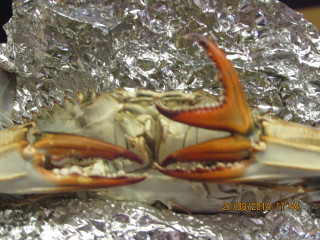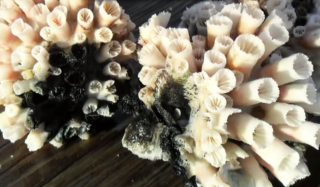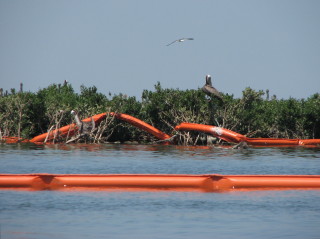
New Managing Director for Bellona Norway
The Board of the Bellona Foundation has appointed former Minister of Climate and the Environment Sveinung Rotevatn as Managing Director of Bellona No...
News

Publish date: February 2, 2015
News
NEW ORLEANS – Millions of gallons of oil from BP’s 2010 Deepwater Horizon blowout have been discovered in the sediments on the Gulf of Mexico’s floor says a new report, giving lie to the petroleum giant’s continue claims that it eradicated the worst consequences of the biggest maritime oil spill in US history.
This and other studies are offering documentary evidence that backs findings by independent researchers who have spoken to Bellona, and begin to assemble the puzzle about where mutated fish life, plunging seafood harvests, continued oily beaches and persisting and emergent human health conditions are coming from.
The Florida State University report, published Friday, comes amid the third and final stage of BP’s civil trial over the spill.
Earlier this month, an expert witness for BP testified that the Gulf’s shoreline had shown “substantial recovery” since the spill, and that BP’s work to clean up the oil had been “comprehensive” and “effective.”

But this and other studies – as well as compelling expert testimony at the trial – show that the spill’s lasting impact on the Gulf – and the amount of oil left in it – are far from being determined. The last week of the civil trial, in which the US Justice Department is seeking $13.7 billion in damages, began Monday.
Florida State published public its study in the Journal of Environmental Science and Technology, and asserted that six to 10 million gallons, or about 238,095 barrels, of oil from the BP spill are buried in the seafloor.
This adds to some 2 million barrels, or 84 million gallons, that an October study by the University of California Santa Barbara said had coagulated at the seafloor around the derelict Macondo well. This report’s lead author, Dr David Valentine, established the spill had left a kilometer “bathtub ring” of oil measuring 1,980 square – roughly the size of the US state of Rhode Island – on the ocean’s floor.
“Based on the evidence, our findings suggest that these deposits come from Macondo oil that was first suspended in the deep ocean and then settled to the sea floor without ever reaching the ocean surface,” Valentine told the UC Santa Barbara Current in late October. “The pattern is like a shadow of the tiny oil droplets that were initially trapped at ocean depths around 3,500 feet and pushed around by the deep currents. Some combination of chemistry, biology and physics ultimately caused those droplets to rain down another 1,000 feet to rest on the sea floor.”
The oil that didn’t reach the surface is widely believed to have been turned into droplets by BP’s experimental deployment of the toxic, cancer causing oil dispersant Corexit at the mouth of the spill.

Christopher Reddy, a marine chemist at Woods Hole Oceanographic Institute and the bathtub ring study’s co-author, said the findings validate earlier research that long-lived deep water coral was coated and likely damaged by the spill.
This corroborates earlier reports on Gulf coral by Bellona.
Florida State’s Methods for finding the oil
Researchers from Florida State University, led by Professor Jeff Chanton, used carbon 14, a radioactive isotope as a so-called inverse tracer to determine where oil might have settled on the sea floor.
Oil does not have carbon 14, so sediment that contained oil would immediately stand out. Chanton then collaborated with Tingting Zhao, associate professor of geography at Florida State, to use geographic information system mapping to create a map of the oiled sediment distribution on the sea floor.
The study showed that an area of approximately 24,000 square kilometers about 100 kilometers southeast of the Mississippi Delta contained sediments low in carbon 14.
“This is going to affect the Gulf for years to come,” Chanton said. “Fish will likely ingest contaminants because worms ingest the sediment, and fish eat the worms. It’s a conduit for contamination into the food web.”
What the study sought
Chanton’s study sought answers to two question: if oil had settled on the sea floor, and if so, how much.
In a separate interview, Chanton told ThinkProgress that he expected to find more oil because so many witnesses to the spill had observed oil clumping on the water surface and sinking. But he told the publication that, regardless of the amount, sedimentation of the oil was a “new phenomenon” which has been overlooked by previous oil spill studies.
No protection from oil flooding cities
The discovery that oil is buried in the Gulf’s sediments means that if it’s stirred up in the future – a well-founded fear in this hurricane-prone area – it would reenter the seawater and storm-driven surges along the coast.

Jonathan Henderson of the Gulf Restoration Network told Bellona in an interview as early as August that: “My biggest fear since the Deepwater Horizon blowout is that a hurricane could send oil literally spilling into the streets of New Orleans.”
Louisiana’s wetlands are getting sucked under by the highest rate of sea level rise in the world, according to National Oceanic and Atmospheric Administration (NOAA).
Their loss is attributable to climate change egged on by corrosive oil pollution. Henderson said without the wetlands’ buffer around New Orleans, hurricanes will be devastatingly stronger upon landfall.
Florida State and UC Santa Barbara results square with other independent studies
The Florida State’s assertions square with figures given to Bellona in August by Scott Porter, a marine biologist with Ecorigs and a former diver with the NOAA, who has conducted underwater studies to determine the number of gallons left in enormous mats off the Louisiana coast.
Porter, like the Florida State report, asserts that oil in the seabed sediment was making its way up the food chain. Porter went further to say he has not eaten any Gulf seafood since the spill for fear it may already be contaminating humans.
Oil in sediment not the only problem
Last summer’s massive and continuing die off of dolphins across Gulf of Mexico states also bear witness to the controversial dispersant Corexit, has been left in the sea beyond BP’s April declaration that clean up activities were completed, said Dr. Susan Shaw, founder and president of the Marine and Environmental Research Institute and School of Public Health at the State University of New York, Albany.

Dr Riki Ott, one of America’s preeminent marine toxicologists and oil spill experts, and director of ALERT, told reporters in an internet conference call with reporters last month that: “Dolphins and humans are at the top of the mammal food chain, and as long as dolphins are getting sick, I am not going to go in the water – The federal government is simply not telling us enough.
More undersea tar mats were discovered even further afield in June off the coast of Florida. According to the state’s Department of Environmental Protection, 566-kilogram (or approximately 150 gallon) tar mat was discovered in the Gulf Islands National Seashore, the Pensacola News Journal reported.
According to the Gulf Restoration Network’s Henderson, tar balls traceable to the BP spill were to be found on Louisiana’s Grand Isle as recently as last month.

The Board of the Bellona Foundation has appointed former Minister of Climate and the Environment Sveinung Rotevatn as Managing Director of Bellona No...

Økokrim, Norway’s authority for investigating and prosecuting economic and environmental crime, has imposed a record fine on Equinor following a comp...

Our op-ed originally appeared in The Moscow Times. For more than three decades, Russia has been burdened with the remains of the Soviet ...

The United Nation’s COP30 global climate negotiations in Belém, Brazil ended this weekend with a watered-down resolution that failed to halt deforest...